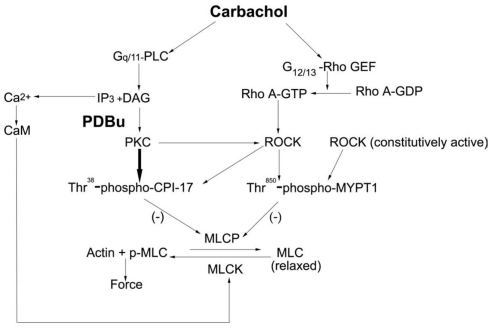Figure 6.
Proposed model for the regulation of bladder smooth muscle contraction. Carbachol stimulation of bladder smooth muscle results in the IP3 dependent release of Ca2+ and MLC kinase-catalyzed phosphorylation of the MLC. Additionally, both PKC and ROCK are activated. PKC directly catalyzes the phosphorylation of CPI-17 while ROCK catalyzes CPI-17 phosphorylation via its activation by PKC. The result is inhibition of the MLC phosphatase and an increase in force. ROCK also catalyzes the phosphorylation of Thr850-MYPT1; however, this is either via a different isoform or pool of ROCK than that which phosphorylates CPI-17. A constitutively active pool of ROCK is present in bladder smooth muscle and is proposed to be responsible for the high basal phosphorylation values of Thr850-MYPT1 due to its inhibition of the MLC phosphatase. PLC, phospholipase C; DAG, diacylglycerol; Rho GEF, Rho guanine nucleotide exchange factor; MLCP, MLC phosphatase; MLCK, MLC kinase; CaM, calmodulin.

